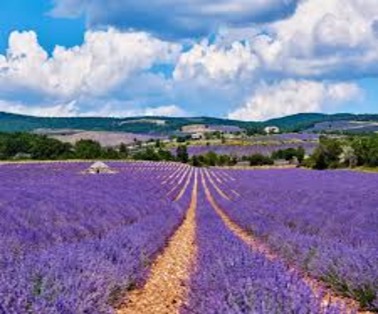Purple Revolution’, which started with the large-scale cultivation of the lavender flower in Jammu and Kashmir’s Bhadarwah, is now attracting farmers from across the country.
Key Points On Purple Revolution
- MoS Science and Technology Jitender Singh told, “Himachal Pradesh is trying to replicate Bhadarwah’s success
- The Uttarakhand government has contacted CSIR (Council for Scientific and Industrial Research) Dehradun.
- Gujarat has also sent a proposal to see if some parts of the state is conducive for lavender cultivation.
- But the biggest success story is from the northeast.
- Where majority were potato, cucumber growers. But this lavender provided an alternative source of income
What is Purple Revolution
- The Union Ministry of Science and Technology initiated the Purple Revolution or Lavender Revolution in 2016 through the Aroma Mission of the CSIR.
- Kashmir is moving towards “purple revolution” as the farmers are slowly switching over from the traditional crops to more rewarding farming of lavender, a purple blossomed aromatic shrub.
- Since 2007 onwards, lavender farming has been introduced in Kashmir and parts of Jammu. It is now picking up revolutionary proportions.
- Lavender farming is now done in all of J&K’s 20 districts.
- Lavender farming was launched as ‘Aroma Mission’ of the Council of Scientific and Industrial Research and Indian Institute of Integrative Medicine, under the Ministry of Science and Technology.
- After the success of Phase I, the CSIR has started Phase-II, which will include over 45,000 skilled human resources and help over 75,000 families.
- According to officials, the climate of J&K is highly conducive for lavender cultivation as this plant can grow in cold temperatures and moderate summers.
- Under the mission, first-time farmers were given free lavender saplings, while those who had cultivated lavender before were charged Rs. 5-6 per sapling.
- The lavender farming is seen as more profitable as compared to the traditional crops and the agriculture department has been conducting awareness campaigns for farmers to inform them about the profitability of this plant.
- Besides, free-of-cost lavender plants were distributed among the farmers interested in lavender farming by the agriculture department. They were also apprised about the know-how of the crop and its yield.
Lavender Of Purple Revolution
- Having an incredibly aromatic smell, lavender flowers have a soothing scent featured in a variety of merchandise, which provides a range of profitable outlets for small-scale producers.
- Unlike many other seasonal crops, producers can dry lavender for ornamental flower arrangements, wands, sachets or potpourri, or transform the dried flowers into value-added products such as essential oils, tinctures, soaps or lotions. It’s also useful in baking and makes tasty honey
- Lavender oil sells for at least Rs 10,000 per litre
- A minimum of 40l of lavender oil is produced from lavender grown over one hectare of land.
- Lavender water, which separates from lavender oil, is used to make incense sticks. Hydrosol, which is formed after distillation from the flowers, is used to make soaps and room fresheners.
Aroma Mission Phase 2
- On February 9, 2021, CSIR-IIIM-Jammu announced Aroma Mission phase 2 after the success of the first phase.
- The mission is to increase lavender cultivation to 1,500 hectares within three years from now
- At present, large-scale lavender cultivation is limited to J&K but governments in Himachal Pradesh, Arunahal Pradesh and Uttarakhand are also encouraging their farmers to take up lavender.
- Small scale farming of the plant is already underway in these states
Aroma Mission
- Aroma Mission was initiated, to popularize aromatic crops and provide end-to-end technology and value-addition solutions to farmers across the country.
- It aims to boost cultivation and value-addition of medicinal and aromatic plants for supply to industries related to aroma business and to the traditional system of Indian medicine, especially in unproductive, marginal wastelands.
- Uttar Pradesh, Uttarakhand, J&K, AP, HP, MP, Odisha, Rajasthan, Gujarat, Karnataka, Chhattisgarh, Tamil Nadu, Maharashtra and Northeastern states are some states that will be covered by the Aroma mission.
- Under it, various economically beneficial aromatic crops including mint, vetiver (Khuskhus), lemongrass, palmarosa (Gandhabel), Ocimum (Tulsi), patchouli (sughandhra), lavender, rosemary, tagetes (marigold/ Gendhe ka phool)), Jammu monarda and Valerian will be taken up.
- This is expected to generate employment among rural youth and create trained and skilled manpower.
- The activities of the Mission will improve availability of quality material on a sustainable basis for a boom in the herbal industry based on essential oils.
Objectives Of Aroma Mission

CSIR
- CSIR was established by the Government of India in September 1942
- It is an autonomous body and the largest research and development (R&D) organisation in India – running 37 laboratories and 39 field stations or extension centres.
- Although it is mainly funded by the Ministry of Science and Technology, it operates as an autonomous body registered under the Registration of Societies Act, 1860.
- The research and development activities of CSIR includes aerospace engineering, Structural engineering, ocean sciences, Life sciences, metallurgy, chemicals, mining, food, petroleum, leather, and environment.
Objectives Of CSIR
- Promotion, guidance and coordination of scientific and industrial research in India including the institution and the financing of specific researchers.
- Establishment and assistance to special institutions or departments of existing institutions for the scientific study of problems affecting particular industries and trade.
- Establishment and award of research studentships and fellowships.
- Utilization of the results of the research conducted under the auspices of the Council towards the development of industries in the country.
- Payment of a share of royalties arising out of the development of the results of research to those who are considered as having contributed towards the pursuit of such research.
- Establishment, maintenance and management of laboratories, workshops, institutes and organisations to further scientific and industrial research.
- Collection and dissemination of information in regard not only to research but to industrial matters generally.
- Publication of scientific papers and a journal of industrial research and development.
To Download Monthly Current Affairs PDF Click here
Get Inspiration from CLAT 2025 Topper
Click here to get a free demo
Everything About CLAT 2025



